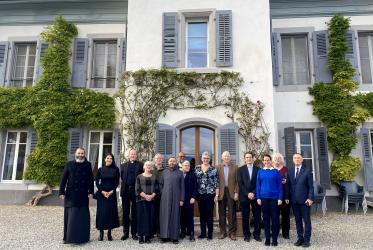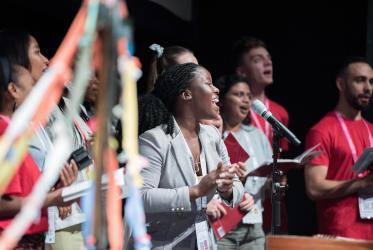(Reflections of theologians representing the Ao and Chang Naga, Aymara, Igorot, Maori, Maya, Mizo, Quechua, Santal, and Turtle Island, who met at Yu-Shan Theological College and Seminary, Hualien, Taiwan from September 17-29, 2012).
Dualism and triumphalism in Christian Traditions
Influenced by Hebrew and Greek thought many Christian traditions have constructed images of God in dualistic and hierarchical ways. Consequently, we have come to imagine God as an incomprehensible and all powerful being. This all powerful, all-knowing, and incomprehensible God is present everywhere, up there, beyond the realms of life here on earth.
Like Gnostics, we tend to believe that such a God of Life cannot be related to the material world. God is purely a transcendental and spiritual being whereas the world is created out of matter, and therefore evil, sinful and destined to destruction. This Holy God is separate and does not come into contact with the fallen earthly world. The traditional Christian view of God as life is shaped by this understanding.
Though God is Spirit, we construct images of God metaphorically. We often perceive God in terms of power and perfection, as Ruler, Lord, King, Almighty, Father, Master and Warrior. These are all conquest and success-oriented images. Though God is merciful, loving, caring, compassionate, a comforter and liberator who shares in our sufferings and, through Jesus Christ, taught us to love and care for one another and to be mutually interdependent, we tend to over-emphasize the triumphalistic images of God.
These images of the God of Life have made Christianity a religion of and for rulers, the elite and the dominant sections of society. Indigenous Peoples feel that such a God is one that liberates no one, not even his own followers, and therefore cannot liberate the poor and the marginalized, the victims of various forms of power, such as Indigenous Peoples, Dalits, women, persons with disabilities, those living with HIV, and other discriminated communities.
Indigenous Peoples reject a concept of God who is seen as the external monarch ruling over the world from above imposing his/her divine laws on it. We believe that God belongs to the earth and comes and dines, drinks, speaks and reveals Himself/herself to us as person. We affirm that God’s creativity, his/her active involvement in this world is not limited to the human realm alone. God works and lives in every being. By hurting the Mother Earth, we hurt our Creator as well as human community. God suffers when God’s creatures are hurt, because God is an integral part of his/her creation. Therefore, God actively works this world to protect the vulnerable ones and wounded earth.
God Incarnate
God became flesh in Jesus of Nazareth so that we could share oneness with God, with one another and with the whole of Creation. In incarnation God does not remain remote and abstract in the world. He/she becomes tangible and visible in Jesus, made up of flesh and blood, rooted in and related to the heat and dust, the rough and tumble of the earth. Thus the Johannine affirmation, “God so loved the world” (John 3:16) and “the Word became flesh.” (John 1:14). These are the defining characteristics of God’s presence in the world. Jesus is not an appearance, a Docetic figure or Gnostic being. Jesus is of the sinful flesh, sarx, belonging to the cosmos, the world. We affirm that God is of this world, and therefore of Life. God is to be experienced in this world and in this life.
Our cosmo-centric vision of life teaches that the Holy Spirit is present in each iota of creation. There is nothing on the earth that has not been touched by the Spirit. In the Old Testament, the Spirit of God is compared with ruah. The Spirit inhabits every creation and gives life. The presence of the Spirit in stones and trees is real. The Spirit makes all living possible. It is through the work of the Spirit that plants are made to germinate, grow and bear fruit and oppressed communities resist for justice. In short, the presence of Spirit makes creation (in the full sense of the whole of God’s Creation) alive and dynamic.
If we want to affirm that God is one of Life, then we must avoid viewing life in terms of power, prosperity, good health, healing, perfection and success. Measuring the active presence of God in terms of power, blessings, money, perfection and success is called ‘prosperity’ theology. This is not the teaching of the Bible, but a domestication of God and truncation of the Gospel.
Life in the God who is Life is measured not in lording it over the people but in loving them, not in what we have but in what we give, not in being perfect but in being compassionate, not in terms of success, but in terms of service.
God is Life, Life is land
Unlike other great religions of the world, Indigenous Peoples’ religious traditions do not have any founders, reformers or guides nor do people dance and sing praises to the Great Spirit; this is the tradition of a number of Indigenous Peoples of North America, Indigenous Peoples in Asia as well as the Mayan traditions . Instead, people dance and sing along with the cycle of seasons of the land – celebrating the expressions and exuberance of life.
One distinct feature of many indigenous forms of spirituality is that their belief systems, ceremonies, rituals, festivals and dances are community expressions that are centered around and deeply rooted in the land itself so much so that the God of Life cannot be understood outside of the relation to land/space. The Aos and Sangtams of Nagaland (India), for example, call their Supreme Being, Lijaba. Li means `land’ and jaba means `real.’ It means the Supreme Being is `the real soil.’ Other communities call the Supreme Being Lizaba. Li means `soil’ and zaba means `enter’, meaning `the one who enters’ or `indwells into the soil.’ Similarly, the Chang Naga also attributes the Supreme Being by the name Mühghaü. Müh meaning ‘skies/heaven’ and ghaü means earth/land. According to the Mayan tradition of Kaqchikel “ru K’ux rubach’ulef”, God is present in entire face of the earth.
Many Indigenous communities believed that God is the one who enters the soil with the seeds and rises again in the crops for food. Thus, the blooming flower and fruits signify the presence of the Creator. God is not only “God of Life” but “God is Life” because the whole Creation is God’s self-expression, love and wisdom. “The whole earth is full of God’s glory” (Isaiah 6:1-3). The whole Creation declares that God is life. Indigenous Peoples, therefore, cannot imagine “God of Life” without a connection to the land; the land and God of Life are inseparably related.
Indigenous theologies reject any concepts that uphold God’s transcendence and holiness that take God away from the earth. Such constructs of God contradict the true message of the Scriptures. The Bible affirms that God became flesh and lived among earth people (cf. Jn. 1). Jesus is the incarnation of God. He gave his life for the liberation of those who are oppressed. We perceive and reflect theologically because we feel His presence among us, the living presence of this God amidst our struggles.
Land and Peace
Justice and Peace are not for a life of prosperity, but for creation of conditions so that human life and God’s entire creation may have the possibility of life, here and now and beyond. Human liberation would be void and empty without the affirmation of the integrity of the goodness of the land and its resources. Shalom without land is not shalom, as it would lead to slavery and destruction.
Therefore, the land and its resources, which sustain and nourish all beings and give them an identity and selfhood, are not merely a justice issue to be set alongside other justice concerns, but the very foundation of history, existence and identity. This implies that poverty, war, oppression, ethnic conflict and identity problems cannot be understood or solved without relating them to the integrity of creation/land.
Doing Justice to Creation
Indigenous religions are centered on the earth itself. The religious practices, rituals, ceremonies, festivals and dances are all centered on the earth. Justice to creation/land then becomes central to peace and human dignity and fullness of life. Hence, doing justice to Creation is the starting point of theology. Commitment and dedication to the harmony of Creation/land springs forth in love, nurture, care and acceptance. This methodological priority to do justice to the totality of Creation challenges us to redefine our ecumenical vision of “God of life, lead us to justice and peace.”
Witness to the God of Life is incomplete without resistance for justice; and believing in the God of Life is to participate in life-giving activities or concrete actions. This demands the conscious rejection of unjust and oppressive systems in society and has to be a crucial option against social structures and in favor of the victims. If ecumenical witness is to be realistic and command credibility in our time, we have to abandon idealistic views of justice and peace, but locate the Kingdom’s value within social structures and resist or develop values collectively for the liberation of the victims.
A True Church
Indigenous Peoples affirm that the true Church has to participate in the creation of a just social order and be called to God’s mission, otherwise it is not a true Church but one that does not participate in creating a just social order is not a true church and is, therefore, not doing God’s mission, but is a mere agent of the oppressors. The church should shun messages of love and peace that are passive. Witnessing the God of Life involves mobilizing people for collective resistance in favor of justice and create a new consciousness of the rights of victims.
Churches that isolate themselves from peoples’ movements, or discourage involvement in organizing such movements for justice, contradict the teachings of Jesus who died on the cross. The God of the Bible is a liberator God and faith in the liberator God calls for struggle against all forces and forms of oppressions. A church that affirms the God of life participates actively in the struggle for the fullness of life. A church that is not in the struggle is dead.
_______________________



